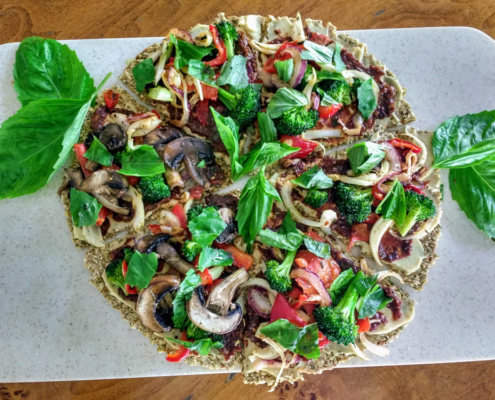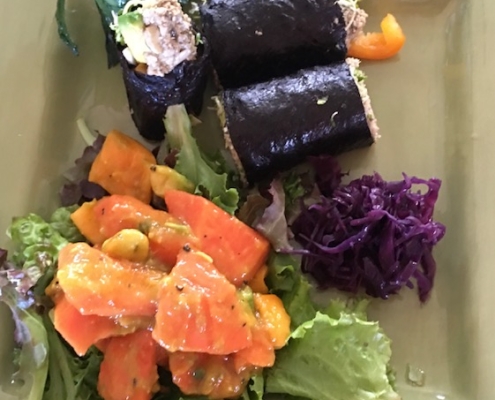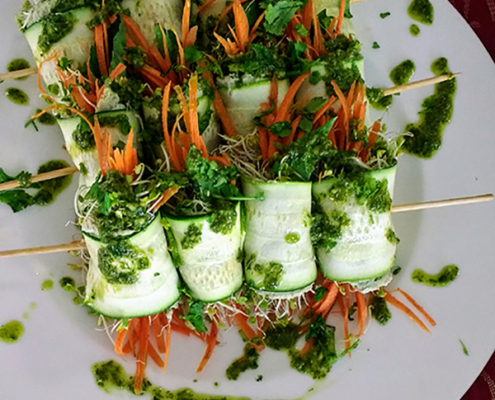Detox for Weight Loss Retreat Hawaii
Get Clear on How Weight Loss is Accomplished During our Weight Loss Retreat
Dr. Baylac prepared these questions and answers to help you understand how weight loss is accomplished during our detox for weight loss retreat. Especially if you’re not sure if this program is right for you, review the questions and answers to get clear on how this program works. Oftentimes people who want to lose weight have already tried multiple approaches, therefor we believe it’s important to feel confident that our weight loss retreat is the right program for you.
1. What is your detox for weight loss retreat?
The weight loss retreat program is designed to encourage the body to burn fat storage for fuel instead of dietary carbohydrates. Fat cells store energy in the form of triglyceride that are broken down into fatty acids to produce energy through a process called ketosis. Chemical toxins and heavy metals stored in fat cells are released in general circulation through this process, impairing metabolism and slowing down weight loss. Our program is designed to maximize both elimination of these toxins and metabolic rate.
2. How do you encourage the body to burn fat?
We mimic fasting, using a ketogenic diet, intermittent fasting, and exercise driving the body into ketosis. Ketosis is a normal metabolic process that the body uses to produce energy from fatty acids when dietary carbohydrates are not available.
3. How does ketosis work?
The body stores excess energy from dietary carbohydrate and proteins into triglyceride in fat cells. The ketogenic diet and intermittent fasting mobilize triglycerides and breaks them down into fatty acids to be used for energy production by the cell in the mitochondria, a process called ketosis.
4. What is a ketogenic diet?
A ketogenic diet is a diet low in carbohydrates to encourage the body to utilize fat reserves for energy. The ketogenic diet eliminates starches like grains or potatoes or legumes. The ketogenic diet induces the production of ketones from fatty acids. The presence of ketones can be tested in the urine to verify that ketosis is reached.
5. What is intermittent fasting?
Intermittent fasting consists of fasting for 16 / 18 hours every 24 hours. Normal over-night fasting is extended for few hours in the morning before brunch and few hours in the evening after dinner. When we fast blood sugar and insulin go down, signaling the body to use fat for energy. Exercising in the fasting state puts a higher demand on the body for energy and stimulates a higher break down of fat.
6. Where does the fat go?
The breakdown of fat produces energy, heat and waste products: carbon dioxide eliminated through the lungs and water eliminated through the urine.
7. How are chemicals and heavy metals eliminated
Chemicals and heavy metals are eliminated with a therapeutic raw detox diet, supplements to support glutathione production and liver detoxification pathways, infrared sauna, dry skin brushing and exercise to increase elimination through sweat and colon hydrotherapy (colonics) to support eliminatation through the colon.
8. What is your therapeutic detox diet?
Out therapeutic detox diet eliminates the following:
- Foods that most people are allergic or sensitive to: wheat, glutenenous grains, dairy products, eggs, soy, corn, peanuts, refined vegetable and seed oils, trans-fats, sugar, high fructose corn syrup, GMO foods and pesticides/conventionally grown foods.
- Non-food substances toxic to the nervous system: stimulants like coffee or caffeinated drinks and mood altering beverages like alcohol.
- Toxic foods contaminated by chemicals and additives: processed foods and sodas or energy drinks.
- Canned foods and beverages packed in plastic containers high in BPA.
- Meat and animal products high in added steroid, growth hormones and antibiotics.
- Seafood high in mercury and contaminated with PCBs.
9. What does the detox diet consist of?
- It is a high nutrient low-calorie plant-based diet made of organic vegetables and fruits, nuts and seeds, fresh avocados and coconuts. Our local farmers supply us with vegetables, greens, herbs, fruits and macadamia nuts. Cashews, almonds, pine nuts, sunflower, pumpkin seeds come from the mainland.
- The food is eaten raw (not heated above 117°F).
- We use maceration, dehydration, fermentation, blending and sprouting to create a wide variety of appetizers, soups, entrees, desserts, smoothies and beverages. We offer a full menu.
- We use only filtered water.
10. What are some examples of food you serve?
Our recipes are inspired by international vegetarian cuisine. We make crackers, patés, nut cheeses, kale chips, soups, entrees like lasagna, pizza, pasta, raviolis, Thai curry with cauliflower rice, quiche, falafels, sushis, salads from all green leafy vegetables, carrots, radish, cabbage, desserts like chocolate mousse, carrot cake, sorbets, vegetable juices and green smoothies.
11. Why do you use raw food for weight loss?
Studies show that people on a high fiber plant-based diet have the lowest body fat compared to people who eat an empty calorie standard American diet. A vegan raw food diet has a low calorie / high nutrient ratio, so people can eat as much food as they want without being concerned about gaining weight, counting calories and feeling deprived.
The raw vegan diet is a sustainable and enjoyable diet, which is needed for long term weight loss success.
12. How do you achieve long term changes?
The reasons for gaining weight must be identified first, then healthy alternatives may be found. Weight gain may be due to overeating to ovoid loneliness, or emotional eating to suppress anger or boredom or lack of physical activity or medical problems like under active thyroid and insulin resistance, or stress and lack of sleep or the side effect of a medication or a negative self-image.
13. How do you help people to accomplish change?
I created a method based on Motivation, Awareness and Practice which we use the acronym MAP for. It consists of being mindful of the psychological triggers leading to the wrong behavior of snacking for instance, re-framing the thoughts and making a conscious decision to substitute a healthy behavior. Motivation to practice is a function of the desire to change. Continued practice of the new behavior create positive reinforcement and a new long term habit.
14. How do you overcome plateaus?
You may be able to lose one pound a day average the first week or two, then the weight loss may slow down or plateaus. This is partly a normal process where the body is adjusting to the new weight and partly due to an overload from toxins. During these periods the dietary and exercise program need to be continued as it is or adjusted if needed. Liver and kidney support may be intensified .
15. How do you overcome weight loss resistance?
Weight loss resistance is when the body does not respond to the basic diet / exercise program for months. It happens often with extreme obesity. Extreme obesity dysregulates hormones involved in weight control. Insulin, cortisol, leptin and thyroid control weight. Other factors include mental-emotional factors, past traumas, sleep, gut bacteria and other food sensitivity. Weight loss resistance can also be a reflection of the resistance to change or the reflection of the fear of change, extra weight can serve as extra protection and may unconsciously signify a desire to be unattractive.
16. Set point
We all have a set point where we feel at our best. When the body reaches this point it let us know with a feeling of pleasure. Plateaus are not set points.
17. Mental and emotional detox
Negative mental and emotional factors have contributed to weight gain. Self-sabotage, self destructive thoughts like I’m not worth or I don’t deserve to be attractive or I’m ugly, can express patterns created during childhood. Changing how you feel about yourself is the key to weight loss. Dare to be attractive and beautiful and think like a thin person even before you lose weight.
18. Mindful eating
Food has become a commodity and eating cheap goes along with eating on the run. Buying good quality foods and feeling that we deserve it, is the first step to treat our body as our temple. Appreciating food and being grateful for the gift of life, honoring our body by putting healthy food in it is a necessary change in mindset to lose weight and maintaining a healthy weight.
10-DAY DETOX FOR WEIGHT LOSS RETREAT
The 10 Day Detox for Weight Loss program combines a raw ketogenic diet, intermittent fasting, fresh juices, detox + weight loss nutrient infusions, detox support + weight loss supplements, infrared sauna, yoga, sunrise walks, colonics, spa treatments and education sessions on weight loss and lifestyle. The program builds a foundation for long-term change. The foundation is built around the six pillars of the program: plant-based diet, physical activity, positive thinking, stress management, social support and commitment.







